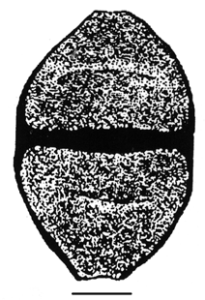Fungalpedia – Note 193, Dyadosporites (Fossil Fungi)
Dyadosporites Clarke
Citation when using this data: Saxena RK & Hyde KD. 2024 (in prep) – Fungalpedia, Fossil Fungi.
Index Fungorum, Facesoffungi, MycoBank, GenBank, Fig. 1
Classification: Didymosporae, Fossil Fungi.
Clarke (1965) described the monotypic fossil genus, Dyadosporites, from Late Cretaceous (100–66 mya) sediments in the Canon City Coalfield, Fremont County, Colorado, U.S.A. According to the original diagnosis, this genus includes bilocular (didymosporous) elliptical spores having a simple central septum, psilate to finely punctate spore wall, and a single pore at the apex of each cell. Kalgutkar & Jansonius (2000) emended the generic diagnosis to include dicellate fungal spores of various shapes and having psilate to variously sculptured spore walls.
The generic name Dyadosporites first appeared in van der Hammen (1954) with D. umeriensis as its type. The diagnosis for D. umeriensis has never been published; therefore, the genus publication was not considered valid. Clarke (1965, p. 90) considered Dyadosporites as validly published and described under it as a single species, D. ellipsus. Clarke (1965) also provided a restated diagnosis for Dyadosporites. Therefore, Dyadosporites is considered valid, and it was published by Clarke (1965) using the principle of monotypy. Elsik (1968) did not consider Dyadosporites as validly published and proposed another genus, Dyadosporonites, with the following diagnosis: “Diporate, uniseptate fungal spores. Shape and ornamentation variable. Single pore at each end of the spore. Pore may be modified, i.e., atrium, annulus or pore chamber formed by a thin septum across the end of spore.” Since Dyadosporites and Dyadosporonites entirely overlap, the latter is considered the latter synonym of the former. Kalgutkar & Jansonius (2000) considered Psidimobipiospora Sal. -Cheb. & Locq. 1980 is also the later synonym of Dyadosporonites.
Synonyms: Dyadosporites Hammen, Dyadosporonites Elsik. Psidimobipiospora Sal. -Cheb. & Locq.
Type species: Dyadosporites ellipsus Clarke (by monotypy).
Other accepted species: (Species Fungorum – search Dyadosporites)
Figure 1 – Dyadosporites ellipsus. Scale bar = 10 μm. Redrawn from Clarke (1965)
References
Entry by
Ramesh K. Saxena, Birbal Sahni Institute of Palaeosciences, Lucknow, India
(Edited by Kevin D. Hyde, Samaneh Chaharmiri-Dokhaharani, & Achala R. Rathnayaka)
Published online 31 January 2024
